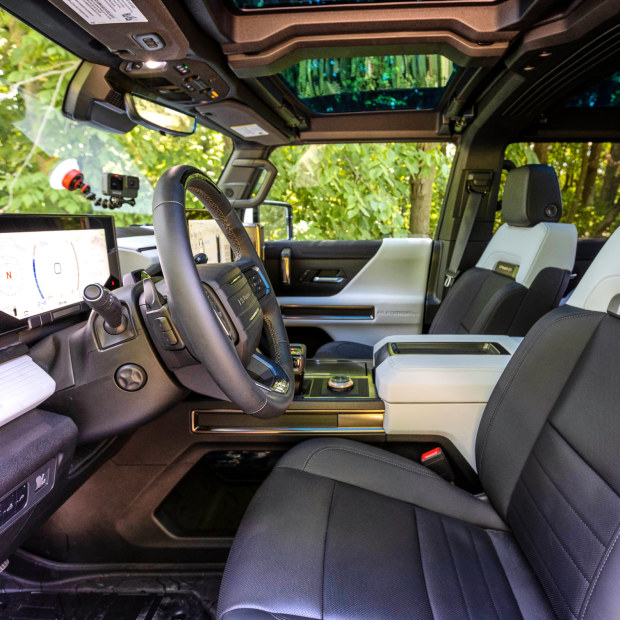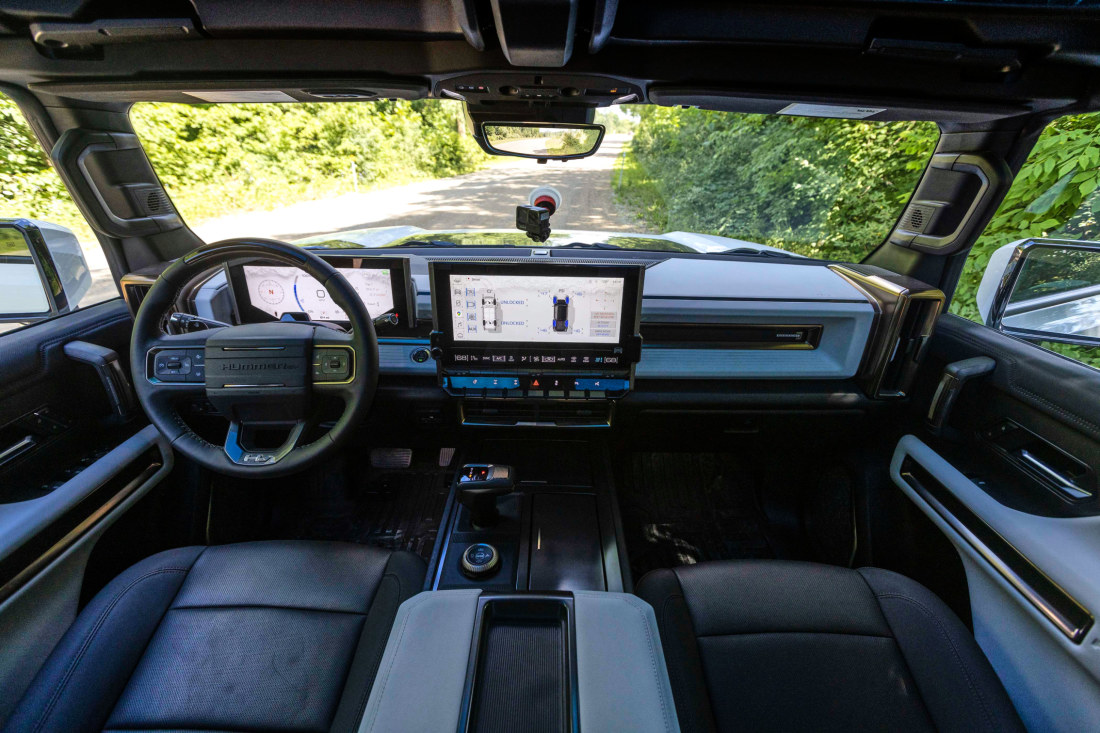[ad_1]
His first piece of advice was to floor it and I did, reaching 100km/h in about four seconds – on gravel. The plume of dirt and rocks thrown up behind us was extraordinary. So was the noise, a combination of motor noise, an artificial soundtrack through the speakers but, above all, four enormous tyres tearing up the ground beneath us.

It’s spartan but comfortable in the front. The glass roof opens up entirely.
The Hummer EV is so fast, so controllable, so instantaneous from the moment the throttle is touched, that I can’t imagine any conventional vehicle keeping up. Greene says it can generate 0.7 G while accelerating on a loose surface, but it’s just as impressive through the twisty stuff.
So, why is electric drive so suitable for off-road? “It’s the precision and control that you have with the electric motors,” Greene says. “We can do things that simply aren’t possible with a mechanical system. It opens up a whole new world of opportunities for using the system for torque vectoring and vehicle dynamics performance, but at the same time, giving you that precision and control that you need for low-speed rock crawling.”
When cresting steep climbs, various camera views allow you to see the trail ahead when the view is otherwise bonnet and the sky.
Greene ran us through what seemed like an endless list of clever electronic features and modes. We put them all to the test. Among the most talked-about is CrabWalk, which makes all four wheels steer in the same direction at slow speed, making the Hummer slew sideways and forwards at once. It feels weird.
“It’s obviously a cool trick to show your friends,” says Greene, “but it’s useful in certain scenarios off-road where, if you become stuck or if you get off your optimal line because you’ve bounced off, or mud is taking you off, this allows you to climb back up onto rocks or a ridge or something like that … to get yourself back in position to climb a hill.”

The view from the driver’s seat. The seats are utilitarian, but note the high-tech screens and copper air vents.
A related trick, magnifying the front steering at the rear by a factor of 1.6 to create a fishtailing effect, enables the Hummer to be threaded around boulders and down narrow, winding dirt trails. The aggressive rear steering (up to 10 degrees) also gives the 5.5-metre long, 2.2-metre wide behemoth the turning circle of a small hatchback.
Greene says the rear steering, along with the virtual diff locks and torque vectoring (achieved by putting the electric motors in or out of sync) “gives the driver a lot of options … you can put this truck into places that physically, it shouldn’t be able to get into, but it’s easy to do so and easy to get back out”.
He suggested Terrain Mode for “low-speed, technical events”. Again the Hummer seemed to do anything asked of it, the lack of powertrain latency and the prodigious torque meaning you can stop in places you wouldn’t otherwise consider, for fear of losing momentum.

It’s fit for any off-road surface, though it doesn’t have the range for the Australian outback.
When cresting steep climbs, various camera views allow you to see the trail ahead when the view is otherwise bonnet and the sky. The regenerative braking, which allows one-pedal driving, is very useful on the way down. It is adjustable via steering wheel paddles. The air spring suspension with adaptive dampers allows you to adjust the ride height and stiffness.
As with the outside, the Hummer interior mimics some original styling cues. One thing to note is the spectacular copper-like finish on the air vents. The seat trim is plasticky, though not in a bad way. It’s nice to the touch and suggests a hose-it-out ruggedness. The bonnet opens to reveal a big cargo area up front, large enough to swallow all the removable roof panels and a fair bit more.
The vehicle introduces GM’s Ultium EV platform and battery system, with the claim it can add 160 kilometres of range with 10 minutes of charging. For ultimate acceleration, which is quoted as 3.1 seconds to 60mph on bitumen, there is a sports mode known as “Watts To Freedom”. Work out the acronym and you’ll realise Elon Musk isn’t the only car baron with schoolboy humour.
The Hummer EV Edition 1 (with optional Extreme Off-Road Package) is $US112,595 in the States (about $162,000), though cheaper versions will follow. No Australian plans have yet been announced – though there has been plenty of interest from potential buyers.
You could argue the Hummer is silly and irrelevant, and will be found more often in the city and suburbs than in extreme off-road situations. It certainly doesn’t have the range to tackle the outback, the weight of 4082kg is hard to defend, and the badge carries plenty of baggage.
All true, but the Hummer is stunning on the rough stuff, and represents clever marketing. By leading with an EV that is fascinating and extremely capable, GM could, when it launches more modest (and hopefully lighter) battery machines, snare people who’d otherwise turn up their noses. The “I bought it because it’s faster, not because it’s electric” justification has worked very well for Tesla.
GMC Hummer EV Edition 1
- Price | $US112,595 (excluding on-road costs)
- Engine | Three electric motors with 210kWh battery pack
- Power/torque | 735kW/1420Nm (estimated torque, see text)
- Consumption | 41kWh/100km (estimate)
- Range | 530km (estimate)
- C0₂ | Zero local emissions
The author tested this vehicle in the US as a guest of General Motors.
[ad_2]
Source link
